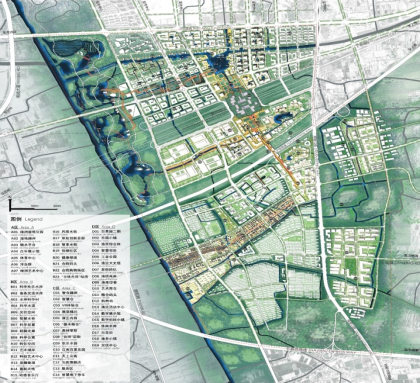The project consortium is led by CAUPD, consisting of Gensler Architecture Consulting (Shanghai) Co., Ltd (Gensler, USA), and China Railway Fifth Survey and Design Institute Group as members. Together, they secured the second prize in the jury committee’s assessment.
The planning efforts focused on addressing the challenges of standalone business function and improving the quality of the new town with its distinctive Jiangnan (South of the Yangtze River) features. A vision is therefore put forward to create a Future City of Core Mobility and Oasis in Water Networks, with three major design concepts: regional magnet, boundless gateway and oasis in water networks.
1.The “regional magnet” seeks to maximize regional value of its core functions. Positioned in the Yangtze River Delta, the plan establishes three regional core functions: science, ecology, and transportation hub, providing sustained development momentum. It aims to create three highly acclaimed regional destinations: a workcation destination, an IPark travel and shopping destination, and a cultural experience destination.
2.The “boundless gateway” models the station city scene with an authentic atmosphere of Jiaxing. By capturing the idyllic texture of Jiaxing, the station architecture incorporates layered rice paddy fields, creating a boundless, step-by-step, pedestrian-friendly urban green space that breaks away from the traditional isolated station-to-city pattern. It embraces the imagery of rice paddies diffusedthe city, transforming the stationa vibrant and integrated part of the urban fabric. Taking cues from the Jiangnan courtyard, the station building is arranged horizontally and vertically to alleviate the sense of confinement caused by its large volume. This arrangement creates a breathing courtyard space within the station, dissolving the boundaries between indoor and outdoor environments. The station extends northward to the terrace field and southward to Qin Lake, seamlessly integrating the two spaces to create a harmonious lake-station living room.
3.The concept of the “oasis in water networks” was employed to capture the essence of Jiangnan characteristic life scenes. Building upon the traditional methods of Jiangnan water management and embankments, the design integrates the existing water system and road network to recreate the double checkerboard pattern of water and land, reminiscent of Jiangnan’s charm. This approach results in a pleasant space with distinct Jiangnan characteristics. The design emphasizes the expansion of water gardens and the development density of science and innovation oases, fostering a vibrant Jiangnan atmosphere with a strong presence in the eastern and western regions surrounding Qinhu Lake. With the oasis encompassing three sides and the city on the other, this design creates a harmonious blend of nature and urban life with Jiangnan style.
The concept of “Future City of Core Mobility and Oasis in Water Networks” represents a new model for China’s station-city integration. It is rooted in the local community, with an orientation towards two centenary goals.

